With the redesigned website officially launched and a new SPACES Archives era underway at the Kohler Foundation, we were inspired to take a deeper look into our history by interviewing the SPACES Board Emeriti to recognize and share their tremendously important work.
The first interview is with Jo Farb Hernández, the SPACES Director and Chief Curator Emerita. Hernández was instrumental in carrying SPACES forward after founder Seymour Rosen's passing. She was the Director of SPACES from 2006 to 2019, and we are incredibly grateful for her work that ensured the success of this exciting transition. Hernández continues to pursue the research and documentation of art environments worldwide and tirelessly advocates for their preservation, contributing to the continuation of the SPACES mission.
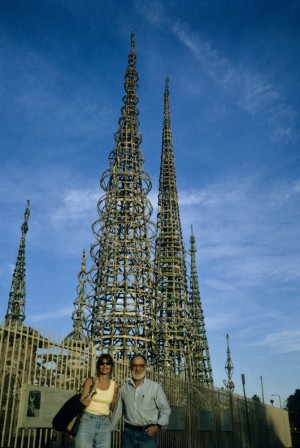
Jo Farb Hernández with SPACES Archives Founding Director Seymour Rosen at the Watts Towers, 2000. Photo: Sam Hernández
How did you get involved with SPACES?
I received a letter from Seymour in August of 1980 introducing himself to me and saying that we had a common research interest in art environments. He’d been given my name from the folks at the Museum of Cultural History at UCLA, who had given me a grant to support my art environment research while I was in grad school there. He had been surprised to know I’d been involved in the field as early as I had. But we continued to correspond back and forth, and then he proposed - I think it was he that proposed, or it’s possible that I proposed to him - the possibility of doing an exhibition together on California art environments at the Triton Museum of Art, where I was the director and chief curator at the time. That’s probably the event that brought us close together. We co-curated the 1985 exhibition [Divine Disorder], installed it at the museum, and it was pretty spectacular. We had ten art environments represented through Seymour’s photos, complemented with physical examples of the artists’ work; by then, several of those sites were no longer extant. Some of these works were later transferred to KFI as SPACES transitioned.
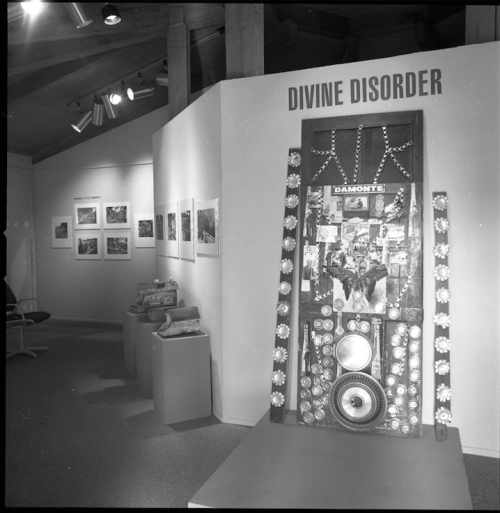
Installation view of Divine Disorder at Triton Museum of Art, Santa Clara, California, 1985
How did you first become interested in art environments?
Actually, through my husband, sculptor Sam Hernández. At Arizona State he hung out with Ron Gasowski, who had been his undergrad teacher at Cal State Hayward, and who had an early interest in the field. Ron documented both folk art traditions and self-taught expressions around the country, and he turned Sam onto some of the sites around Arizona. When Sam moved up to Wisconsin for his MFA, he learned about local sites from his professor Wayne Taylor, and then, when Sam and I met, we started going out to visit art environments on weekends or whenever we could. I just got really turned onto them. I ended up doing my master’s thesis project at UCLA on art environments in 1974-75, concentrating on a north-south slice of the U.S., from the upper Midwest through Texas. The sites make me smile; the artists' passion is so inspirational to me.
I come from a family of artists; my dad was an artist, my uncle was an artist, my sister is an artist, my husband is an artist, practically everybody that I know is an artist, but I don’t know any [academically-trained] artist who works with the intensity of art environment builders. They’re 24/7 involved in their work because in many instances they’re physically living inside of it. And that passion just really inspires me. Sam has teasingly accused me of becoming like them in that my research projects about art environments never seem to end: there’s always one more site to look at or one more artist to investigate. So it’s kind of a never-ending research project, like the never-ending characteristic of art environments themselves. Although, at some point soon, I'm going to have to stop researching works for this second volume of Singular Spaces so I can finish writing and get it published!
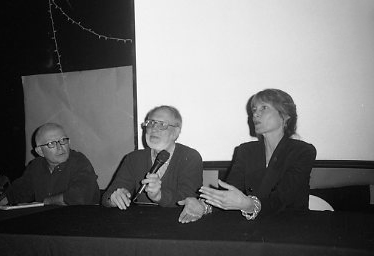
Tom Patterson, Seymour Rosen, and Jo Farb Hernández at a panel at Intuit: The Center for Intuitive and Outsider Art in Chicago, 2004. Photo: Len Farb
You’ve seen so much happen with SPACES, but could you sum up what you’re most proud of that SPACES has achieved since its impetus, or since you’ve been involved?
I think the most important thing is that I really believe Seymour helped define this genre of art. It didn’t have a name (although it still kind of doesn’t have a name!), but it was seen as something that was extremely idiosyncratic, extremely unusual, a one-off, basically, and I think he can really be credited with establishing art environments as a separate genre of art. Now that these works are recognized as a legitimate genre, I think that the world has Seymour to thank for that. Not that he was the only person documenting them, but I think that, more than others, he was really publicizing them to a wide range of people, and insisting that this [genre of art environments] was important. At first they [Seymour and his friends] thought that Watts Towers was the only example of this kind of material, and then they did a little more looking and they thought, well, this is actually a California thing. All these people in California are making these art environments [because California is different from other states] and then, incrementally, they began to realize that, no, they’re all over the U.S., and then, finally, they realized they exist all over the world. I think it was like concentric circles moving out when a pebble is tossed in a pond: it was an incremental understanding of the breadth of the field. I think, in particular with the international work that I've been able to do, it has really codified, especially for American researchers, that there are amazing sites all over the world.
The other thing that I believe is important about SPACES is that we do primary research. We’re not just copying what we see on the internet or taking somebody else’s images that we find online. Everything that we post, we get permission to post. Although some of the photographs come from people doing “drive-by” documentation, the basis of what we do and the way we approach programming is academically-based. We try to get as many points of view represented when we’re looking at the material as possible. So I don’t just talk to the artist, for example; I talk to the family, I talk to researchers, I talk to the guy at the local bar, I talk to as many community members as possible, I even get involved in talking to local government officials, if necessary, to try to get a really complex understanding and to work with and support the artists. I worked closely with Josep Pujiula from early 2000 until he died in 2016, for example, and I’m still in regular contact with the family. I have a different kind of relationship with these artists than the one I have with an artist to whom I might give an exhibition at the gallery at school. This is long-term. It’s a commitment. I want to be there for them when they need my help in terms of advocacy or anything else.
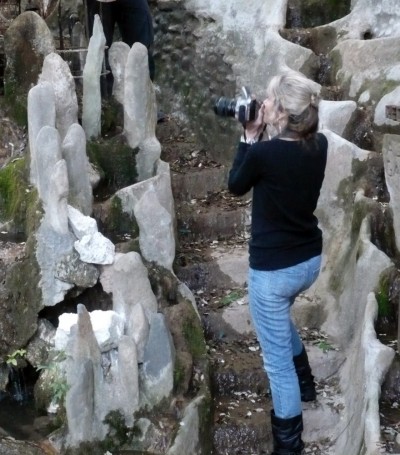
Hernández at the Pujiula site in 2013. Photo: Sam Hernández
What sites have you been the most involved with?
I’ve been concentrating on Spain since 2000, but the early work that I did was in the States and in France. I was at [Ferdinand] Cheval’s palace [Palais Idéal] in ‘76 for the first time—before you could almost even find it. It was kind of bizarre. People were very embarrassed about it. Certainly Fred Smith was an early love. We went up in 1974 and 1975, and interviewed Fred when he was in the nursing home. Sam remembers pushing him around in a wheelchair. Fred said, “Go faster, go faster!” By that time he was just this skeletal little guy, but he wanted his adrenaline hit by speeding along in the chair. It was pretty great. Over the years, having the opportunity to meet the artists... the sites blow me away no matter what, but it's meeting the artists and the transmission of the excitement about their work and their devotion to it that is important, especially in the face of sometimes less-than-appreciative support from family members. With each new site I visit and document, I try to learn as much as I can and spend as much time as possible, and I ultimately count each of these artists as friends. Even after the artist’s passing, I often remain in contact with the families and we keep in touch about the status of the work.
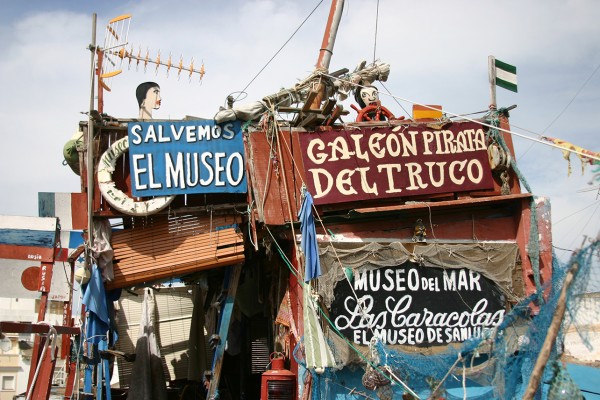
José María Garrido's Museo Del Mar "Las Caracoles", Sanlúcar de Barrameda, Spain, 2009. Photo: Jo Farb Hernández
What’s next for you?
This summer I’m going back to Spain, if possible (due to the Covid-19 crisis things are up in the air at the moment). I’m going to try to “finish” fieldwork for the second volume of Singular Spaces - putting "finish" in quotes because I learn about new sites all the time! But I’m committed to completing this project as soon as I can. I don’t know what that means—three years maybe, if I’m lucky. Because at the end of 2018, for example, I went to the Canary Islands by myself and visited six new-to-me art environments (I later returned to document a newly-“discovered” seventh the following year). In Lanzarote, I met an artist who really impacted me on a lot of different levels. He died less than five months later. So time is of the essence. And although there are younger people who are working in this genre, I think it will take another twenty years before their work really turns into something spectacular. I think this older bunch of artists who worked in Spain, displaying these idiosyncratic public expressions of their creativity during a period where any kind of deviation from the norm that Franco set was suspect—they’re really a special bunch. It was illegal to congregate more than two or three people on the street in areas of Spain where Spanish is not the first language, like Catalunya or Galicia or the Basque Country. They couldn’t speak those languages publicly. There was such terrible repression that tens of thousands of people, maybe hundreds of thousands of people, his own countrymen, were killed by Franco’s forces. And yet, in the face of that, these people built these monumental art environments. Talk about strength of character and passion! You know, just the need to express themselves creatively in this non-sanctioned way may have put them at risk. But they did it anyway. It’s pretty impressive.
And, of course, wherever I am, I’m always looking, although unless I’m working on a special project I generally do less rigorous documentation when I’m not in Spain. For example, a couple of years ago I was running the Cal State University program in Spain (Madrid and Granada). Sam and I took a spring break trip to Morocco, and I didn’t even bring my camera. It’s like—I’m going to Morocco—I’m going to go eat tajine and look at cool textiles, and, damn, if I didn’t find three environments there, just in passing! Luckily, Sam and I both had phones so we could take pictures with both until the batteries ran out. And I was in Mexico briefly last spring and was able to photograph a wonderful site there [Anado McLaughlin’s Casa de las Ranas]. I’m always documenting them and always looking for new sites, keeping my eyes and ears open. Now that I’ve retired from my job as Professor and Gallery Director at San José State, I’m researching and writing about art environments 24/7, and I expect to continue to do so for quite some time to come.
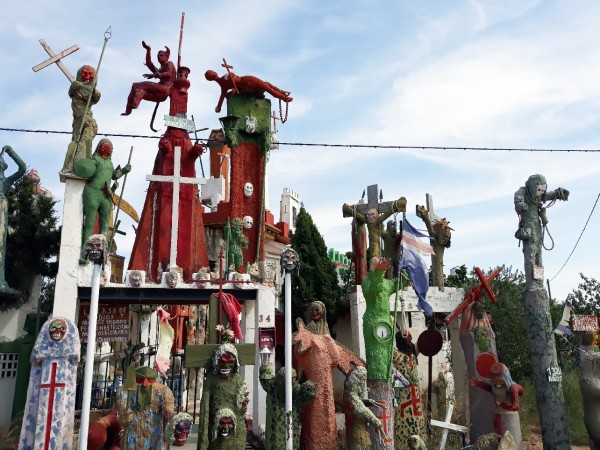
Julio Basanta's Casa de Dios, Épila, Spain, 2018. Photo: Jo Farb Hernández
What do you hope to see for the genre of art environments in general?
I want to see a greater appreciation and support of them by a wider range of people. By this I mean government officials, urban planners, and others who find these sites to be threats to their communities in some way. I’ve been fighting for David Lee Hoffman’s site The Last Resort in Lagunitas, California, for example. The judge just gave the site a sixty-day reprieve [as of the time of this interview–June 2019]. But it’s insane. It’s Marin County. This is where all the Deadheads and the counterculture people hung out with writers, and poets, and artists. Yet the urban planners of today are super threatened by this guy’s art environment. In situations where sites have been threatened with demolition and we’ve been alerted early enough so that we can get in and help fight the good fight—we’ve been successful, in several cases, which makes me feel really good. I use Hauterives in France [the location of Palais Idéal] as a good example. At first, locals were embarrassed by the site. It was overgrown, it was hard to find, nobody wanted to talk about it, and now the whole village is being sustained by the tourists who come to visit the art environment. Not all of it is in good taste, and Roger Cardinal and I have had this conversation; [Cardinal said], “Oh, I liked it better before, when I was the only one there.” But you know—now the site has been saved, and it will be there in perpetuity because now people understand its value. I appreciate the concept and the luxury of being the only one there. But if more and more people are able to see the value, there’s a greater chance the site will be preserved.
Anything to add?
I think it's really important work that we’re doing—especially in terms of the sites that are no longer with us. The fact that we have documentation of them is very, very, very important to the whole history of art—to try to broaden the understanding of what art can be and what art is. And I think that our work at SPACES has been crucial to broadening that definition.
To stay updated on Hernández's work, you can visit her website www.jofarbhernandez.com and contact her at jo@jofarbhernandez.com.
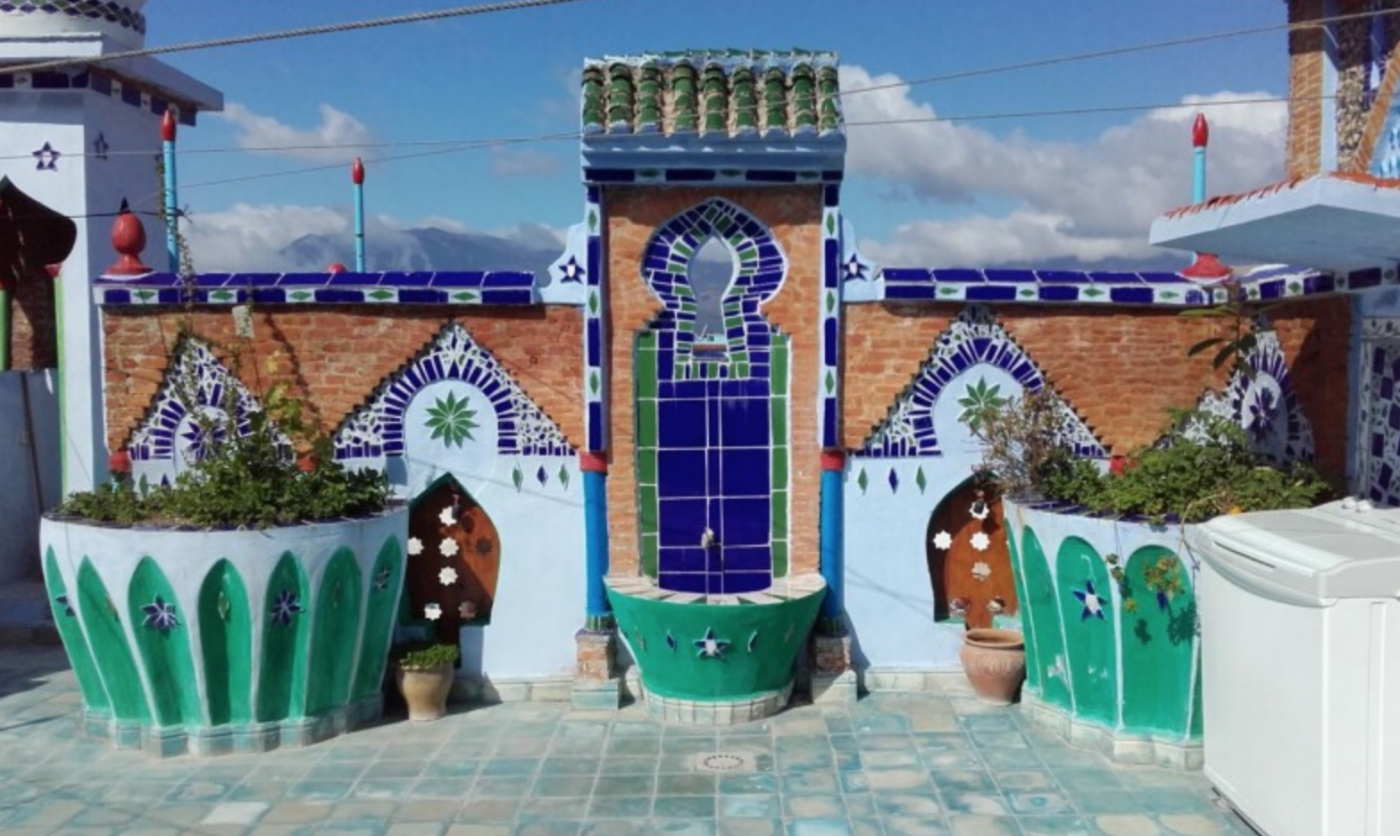

Post your comment
Comments
No one has commented on this page yet.